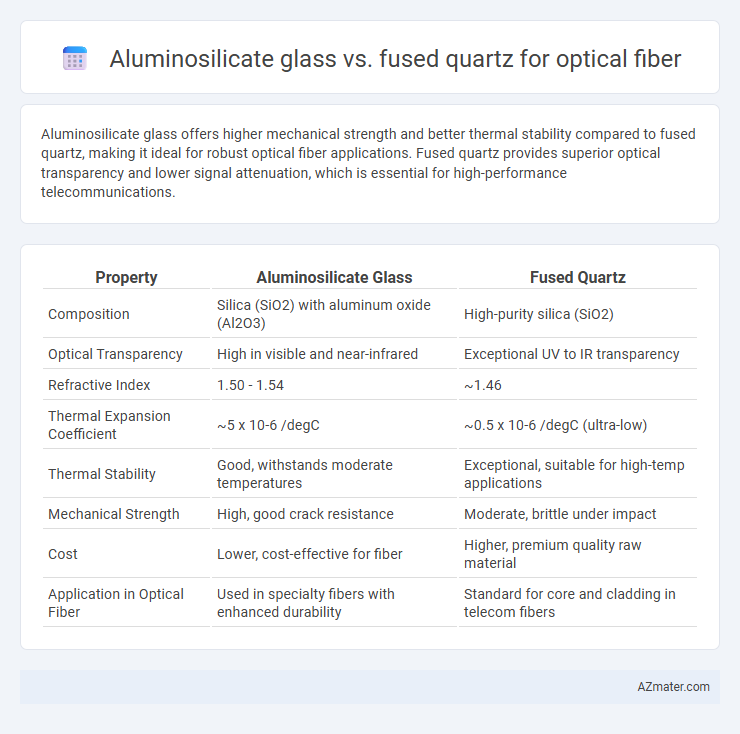Aluminosilicate glass offers higher mechanical strength and better thermal stability compared to fused quartz, making it ideal for robust optical fiber applications. Fused quartz provides superior optical transparency and lower signal attenuation, which is essential for high-performance telecommunications.
Table of Comparison
| Property | Aluminosilicate Glass | Fused Quartz |
|---|---|---|
| Composition | Silica (SiO2) with aluminum oxide (Al2O3) | High-purity silica (SiO2) |
| Optical Transparency | High in visible and near-infrared | Exceptional UV to IR transparency |
| Refractive Index | 1.50 - 1.54 | ~1.46 |
| Thermal Expansion Coefficient | ~5 x 10-6 /degC | ~0.5 x 10-6 /degC (ultra-low) |
| Thermal Stability | Good, withstands moderate temperatures | Exceptional, suitable for high-temp applications |
| Mechanical Strength | High, good crack resistance | Moderate, brittle under impact |
| Cost | Lower, cost-effective for fiber | Higher, premium quality raw material |
| Application in Optical Fiber | Used in specialty fibers with enhanced durability | Standard for core and cladding in telecom fibers |
Introduction to Optical Fiber Materials
Aluminosilicate glass and fused quartz are two primary materials used in optical fiber manufacturing, each offering distinct advantages in transmission efficiency and durability. Aluminosilicate glass provides enhanced mechanical strength and thermal stability, making it suitable for harsh environments, while fused quartz ensures superior optical clarity and low attenuation for long-distance communication. Selection between these materials impacts fiber performance, signal loss, and application-specific reliability.
Overview of Aluminosilicate Glass
Aluminosilicate glass, characterized by its high aluminum oxide content, offers excellent mechanical strength and thermal stability compared to fused quartz in optical fiber applications. Its enhanced durability and resistance to thermal shock make it ideal for harsh environments and high-performance communication systems. Aluminosilicate glass also features a tailored refractive index, improving signal transmission efficiency and minimizing attenuation in fiber optics.
Overview of Fused Quartz
Fused quartz is a high-purity form of silicon dioxide (SiO2) renowned for its exceptional optical transparency and low thermal expansion, making it ideal for optical fiber applications. Its superior resistance to thermal shock and minimal attenuation at ultraviolet to infrared wavelengths ensures reliable signal transmission over long distances. Compared to aluminosilicate glass, fused quartz offers enhanced purity and stability, resulting in higher optical clarity and improved performance in demanding environments.
Chemical Structure Comparison
Aluminosilicate glass consists primarily of silica (SiO2) combined with alumina (Al2O3) and other metal oxides, creating a complex network that enhances chemical durability and mechanical strength for optical fibers. Fused quartz is composed almost entirely of pure silicon dioxide (SiO2) with a highly ordered amorphous structure, providing superior optical clarity and low thermal expansion. The presence of alumina in aluminosilicate glass alters the glass matrix bonding and increases refractive index variance, whereas fused quartz maintains a simpler structure optimized for minimal signal attenuation.
Optical Transmission Properties
Aluminosilicate glass offers enhanced optical transmission properties in the visible to near-infrared spectrum due to its lower attenuation and higher resistance to radiation-induced defects compared to fused quartz. Fused quartz, characterized by its high purity and ultra-low optical loss, exhibits superior transmission in the ultraviolet range but generally has a narrower transmission window and higher susceptibility to defects under harsh conditions. Selecting aluminosilicate glass over fused quartz improves long-distance signal fidelity and durability in optical fiber communication systems operating primarily in the telecom wavelength bands.
Mechanical Strength and Durability
Aluminosilicate glass exhibits higher mechanical strength and resistance to surface damage compared to fused quartz, making it more durable for optical fiber applications under stress and bending conditions. Fused quartz, while highly pure and thermally stable, tends to have lower toughness and is more prone to crack propagation when subjected to mechanical strain. The enhanced hardness and chemical durability of aluminosilicate glass translate to longer service life and improved performance in harsh environments for optical fiber uses.
Thermal Stability and Performance
Aluminosilicate glass offers enhanced thermal stability and mechanical strength compared to fused quartz, making it suitable for high-temperature optical fiber applications. Fused quartz provides exceptional purity and low optical attenuation but has a lower softening point, limiting its performance under extreme thermal cycling. The higher thermal expansion coefficient of aluminosilicate glass improves resistance to thermal shock, ensuring consistent signal transmission in demanding environments.
Cost and Manufacturing Considerations
Aluminosilicate glass offers cost advantages over fused quartz due to its lower raw material and production expenses, making it a more economical choice for optical fiber manufacturing. The higher melting point of fused quartz requires specialized equipment and energy-intensive processes, increasing manufacturing complexity and overall cost. Aluminosilicate glass also allows for faster production rates and better scalability, enhancing its practicality for large-scale optical fiber fabrication.
Application Scenarios in Optical Fiber
Aluminosilicate glass is preferred in optical fiber applications requiring enhanced mechanical strength and resistance to thermal shock, making it ideal for harsh environments such as industrial sensing and high-power laser delivery. Fused quartz excels in scenarios demanding exceptional purity and low optical attenuation, commonly used in telecommunications and long-haul fiber optic networks due to its superior transparency and minimal signal loss. The selection between aluminosilicate glass and fused quartz depends on balancing durability with optical performance to optimize fiber functionality for specific applications.
Future Trends and Developments
Aluminosilicate glass offers enhanced mechanical strength and resistance to thermal shocks, making it a promising material for next-generation optical fibers requiring durability in harsh environments. Research focuses on optimizing its composition to improve optical transparency and reduce signal attenuation, addressing the limitations of traditional fused quartz fibers known for superior purity but higher fragility. Emerging developments aim to integrate advanced doping techniques and nanoscale reinforcement to push the boundaries of fiber performance, especially for high-capacity telecommunications and sensing applications.

Infographic: Aluminosilicate glass vs Fused quartz for Optical fiber
 azmater.com
azmater.com